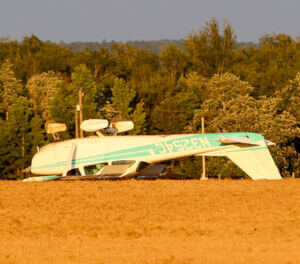Here are the stories for today...
Of note, the release of two ARFF related Advisory Circular update notifications from the FAA.
Be safe out there!
Tom
Small Plane Crashes Near Highway 29 In Bluff Springs
NorthEscambia.com
A small single-engine plane crashed Wednesday evening in Bluff Springs.
Wednesday evening in Bluff Springs.
A witness reported the plane flying just over the treetops before the pilot attempted an emergency landing in a freshly plowed field. The witness said the plane then flipped over. The crash, which occurred around 6:45 p.m., was several hundred feet east of Highway 29, just north of Bluff Springs and Byrneville Roads.
The pilot and a passenger were able to walk away from the crash and depart in a private vehicle. Authorities were told that they said they were going to an area hospital, but that was not confirmed.
According to Federal Aviation Administration registration data, the 1967 Cessna 172H belongs to an individual in Atmore.
The FAA was notified of the crash and will be in charge of the investigation.
https://www.northescambia.com/2025/07/small-plane-crashes-near-highway-29-in-bluff-springs
Advisory Circulars Update Notification
The following advisory circulars have recently been added/updated.
150/5210-17C - Programs for Training of Aircraft Rescue and Firefighting Personnel
Description
This AC provides information on courses and reference materials for training of Aircraft Rescue and Firefighting (ARFF) personnel. This revision replaces Appendix 1 with an Addendum of Aircraft Rescue and Firefighting (ARFF) Training Facilities, which the FAA will update on a quarterly basis. It also removes the one minute time requirement for donning of Personal Protective Equipment and the Self-Contained Breathing Apparatus.
Content
150/5230-4C - Aircraft Fuel Storage, Handling, and Dispensing on Airports
Description
This AC contains specifications and guidance for the storage, handling, and dispensing of aviation fuel on airports. It also provides standards and guidance for the training of personnel who conduct these activities.
Please see the associated Addendum for a list of companies offering courses of instruction in line service training as well as supervisory training that are acceptable to the Administrator. We will update the Addendum on a quarterly basis.
Content
Address for National Air Transportation Association (NATA) – Safety 1st Program (VA) updated 7/10/2025

NTSB Prelim: Cessna 172
The Airplane Came To Rest Underneath A Set Of Damaged Power Distribution Lines On The Floor Of A Coulee
Location: Billings, MT Accident Number: WPR25FA182
Date & Time: June 19, 2025, 14:12 Local Registration: N79306
Aircraft: Cessna 172 Injuries: 1 Fatal
Flight Conducted Under: Part 91: General aviation - Personal
On June 19, 2025, at 1412 mountain daylight time, a Cessna 172K airplane, N79306, was destroyed when it was involved in an accident near Billings, Montana. The pilot was fatally injured. The airplane was operated as a Title 14 Code of Federal Regulations (CFR) Part 91 personal flight.
Preliminary ADS-B data provided by the Federal Aviation Administration showed that the airplane departed Ostlunds Airport, Billings, Montana at 1407 in a climbing left turn to the southeast. At 1411 the airplane overflew a private ranch and the flight track subsequently ended at 1412 about 230 ft southeast of the accident site.
The airplane came to rest underneath a set of damaged power distribution lines on the floor of a coulee. The debris field was contained within about a 75 ft by 75 ft area. The first identified point of contact (FIPC) was a ground scar consistent with the leading edge of the left wing. Red colored glass fragments consistent with the left wingtip navigation light were noted at the outboard end of the ground scar.
The main wreckage was upright, about 18 ft from the FIPC, and was oriented on an approximate heading of 200° magnetic, at an elevation of 3,770 ft mean sea level. Evidence of a postcrash fire was observed throughout the wreckage.
All major components of the airframe, all primary flight controls, and the engine and propeller assembly were observed throughout the debris field. Flight control continuity was established on scene. The elevator trim was found to be in the neutral position, and flaps were observed in the fully retracted position. Both fuel tanks sustained hydraulic deformation consistent with the tanks containing a quantity of fuel at the time of impact. Postaccident examination of the airframe and engine revealed no preimpact mechanical anomalies or malfunctions that would have precluded normal operation.
The wreckage was transported to a secure location for further examination
FMI: www.ntsb.gov

Today in History
40 Years ago today: On 10 July 1985 Aeroflot flight SU5143, a Tupolev Tu-154, crashed near Uchkuduk, Uzbekistan, after entering a flat spin, killing all 200 occupants.
| Date: | Wednesday 10 July 1985 |
| Time: | 23:46 |
| Type: | Tupolev Tu-154B-2 |
| Owner/operator: | Aeroflot / Uzbekistan |
| Registration: | CCCP-85311 |
| MSN: | 78A311 |
| Year of manufacture: | 1978 |
| Total airframe hrs: | 12443 hours |
| Cycles: | 5660 flights |
| Engine model: | Kuznetsov NK-8-2U |
| Fatalities: | Fatalities: 200 / Occupants: 200 |
| Other fatalities: | 0 |
| Aircraft damage: | Destroyed, written off |
| Category: | Accident |
| Location: | near Uchkuduk - Uzbekistan |
| Phase: | En route |
| Nature: | Passenger - Scheduled |
| Departure airport: | Karshi Airport (KSQ/UTSL) |
| Destination airport: | Ufa Airport (UFA/UWUU) |
| Confidence Rating: | Information is only available from news, social media or unofficial sources |
Narrative:
Aeroflot flight SU5143, a Tupolev Tu-154, crashed near Uchkuduk, Uzbekistan, after entering a flat spin, killing all 200 occupants.
Aeroflot flight 5143, a Tupolev Tu-154, departed Karshi (KSQ) on a flight to Leningrad (LED) via Ufa (UFA).
The flight climbed to the cruising altitude of 11.600 m and maintained an airspeed of 400 km/h, which was close to stall speed under the given conditions. During cruise flight vibrations started because of the low airspeed. The crew assumed that the vibrations were caused by engine surges. They reduced power to flight idle, causing the airspeed to drop to 290 km/h. Trying to maintain altitude, the angle of attack increased until the airplane eventually stalled. The Tu-154 went into a flat spin and crashed.
Cause (translated from Russian):
The cause of the accident was the aircraft entering a flat spin during the flight at a jet stream altitude with a high aircraft weight, influenced by high non-standard outside air temperature, low margin of angle of attack, and engine thrust. In these flight conditions and rapidly developing catastrophic situation, the crew deviated from the requirements of the flight manual, lost speed, and failed to maintain control of the aircraft.
